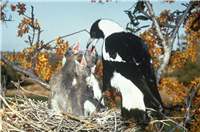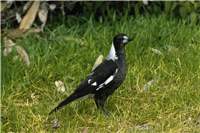Family
Cracticidae
Genus
Gymnorhina
Species
tibicen
Local/Urban Actions
Take notice of the any signs around the suburbs warning of swooping magpies during the breeding season. Due to the sometime scary nature of swooping magpies, Environment ACT offers Magpie education kits on their website at: http://www.environment.act.gov.au/petsandlocalwildlife/localwildlife/livingwithmagpies/magpieeducationkitEnvironment ACT also has pamphlets on living with Magpies: http://www.environment.act.gov.au/__data/assets/pdf_file/20246/living_with_magpies_web_layout.pdf
In the case of overly aggressive birds please contact and urban Wildlife Ranger.Mitchell Depot (Northside) 6207 2113Athlon Depot (Southside) 6207 2087
Common Names
Australian Magpie, Magpie, Black-backed Magpie, Maggie, Long-billed Magpie, Flute Bird, Piping Crow -shrike
Distinguishing Features
A medium sized bird around 30-40cm from beak to tail. The magpie is an easy to recognise bird due to distinctive black and white markings. The body is solid black apart from white plumage found on the tips of the wings, the base of the tail and the back of the neck. Can often be observed in groups and heard calling.
Survey Techniques
Easily recognisable call and visual identification.
Species Call
A loud, warbling, flute-like series of whistles.
Similar Species
May sometimes be confused with the Pied Currawong (Strepera graculina ), due to similarities in body shape and colouring, but the Currawong lacks the Magpie's white spot on the back of the neck. The Magpie-lark (Grallina cyanoleuca ) also has black and white colouring, but the Australian Magpie has a much larger and more solid body shape.
Distribution
Most of Australia, excluding the Northern edge of the N.T and QLD, Victoria, TAS and the southern edge of WA.
Country of Origin
Australia
Conservation (Pet/Pest) Status - Regional
In the surveys since 1981, the species was the most commonly recorded of all birds (COG). Numbers increased slightly over this time.
Conservation (Pet/Pest) Status - National
Secure, not listed under the EPBC Act 1999.
LSCCES Population
This was this most commonly recorded species over the Lower Sullivan's Creek Catchment, with high numbers across all areas.
Associated vegetation community
Naturally prefers open country such as grassy plains, or the edge of forests, although is common within the suburbs of the ACT.
Limiting Resources
The Magpie requires mature trees or similar structures for roosting.
Breeding
The ACT breeding season is recognised from August through to January. Nest building has been observed from July through to October and young have been sighted from July through to January. The nest is an untidy bulk of sticks, built on a tree fork and lined with grass. The 1-6 eggs are tinted blue with red-brown markings. The female incubates them for 20 days and then feeds the young for the first four weeks, as the male is preoccupied with defending the territory.
Behaviour
Magpies are a diurnal species. They form long lasting bonds between pairs. Magpies can often be heard calling to mark out territory and may become fiercely territorial when rasing young, sometimes swooping at unsuspecting passers-by during the spring months.
Functional Group
Food Species
Magpies are opportunistic feeders and the extensive food list includes seeds, grains, fruit, small invertebrates such as worms, cockroaches, grasshoppers, frogs, skinks and small rodents. Generally most food that can be found at ground level is acceptable.
Predators
Australian Ravens (Corvus coronoides ), Monitor Lizards (Varanus indicus), Cats (Felis catus), Barking owls (Ninox connivens) and various snakes all predate the Australian Magpie.
Interesting Fact
During nesting, male Magpies may experience surges of hormones up to 10 times their normal level. This may explain the increase in protective behaviour such as swooping during the nesting season. Some cyclists place googly eyes or long plastic antennas on their helmets to lesson the risk of being swooped.
References - (reader suitability of references, P=Primary teachers, S=Secondary students, T=Tertiary students and researchers)
Books:Canberra Ornithologists Group. 2000. Birds of Canberra gardens. Canberra Ornithologists Group and Urban Services, ACT Government, Canberra. P,S,T
Kaplan,G. 2004. Australian Magpie; Biology and Behaviour of an Unusual Songbird. CSIRO publishing, UNSW press. Victoria, Australia. P,S,T
Morcombe, M. 2000. Field Guide to Australian Birds. Steve Parish Publishing. Archerfield. Australia P, S, T
Slater.P, Slater. P, Slater. R.1997. The Slater Field Guide to Australian Birds. Lansdowne. Sydney, Australia. P,S,T
Internet:Birds in Backyards. 2006. [online]. Available at:http://www.birdsinbackyards.net P, S, T
Canberra Ornithological Group (COG). 2004. Birds of Canberra Gardens. COG and the ACT Department of Urban Services. [online]. Available at:http://garden.canberrabirds.org.au/ P, S, T
Environment ACT. 2006. Environment ACT. [online]. Available at:http://www.environment.act.gov.au S, T
Online Publications: Nix, H. and Cunningham, R. 2006. Birds of the Lower Sullivans Creek Catchment, Canberra ACT. Prepared for the Life in the Suburbs project using data from the Lower Sullivans Creek Catchment Ecological Survey (LSCCES). Australian National University. Canberra. [online]. Available at: http://www.lifeinthesuburbs.com.au/category.php?id=65 S, T


 Top
Top Top
Top